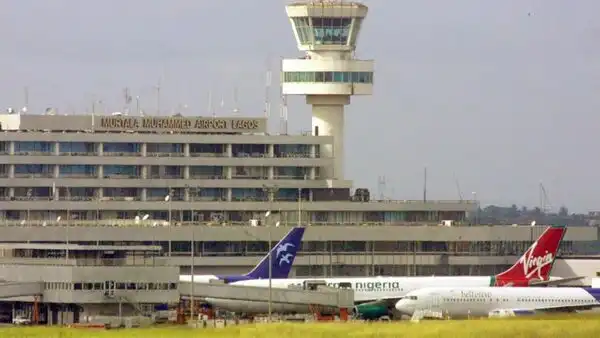
Airport, Lagos
The International Air Transport Association (IATA) yesterday introduced its expectation for airways to attain a collective web profit of N12.2 trillion ($33.eight billion), being four.1per cent web margin, in 2018.
IATA, the worldwide clearing home for over 280 airways world wide, disclosed this projection on the 74th IATA Annual General Meeting in Sydney.
The projection is a strong efficiency regardless of rising prices, primarily gasoline and labour, but in addition the upturn in the rate of interest cycle. These rising prices are the primary driver behind the downward revision from the earlier forecast of $38.four billion in December 2017.
In 2017 airways earned a file $38.zero billion (revised from the beforehand estimate of $34.5 billion). Comparisons to this, nonetheless, are severely distorted by particular accounting objects comparable to one-off tax credit which boosted 2017 earnings.
Profits on the working degree, although nonetheless excessive by previous requirements, have been trending slowly downwards since early 2016, as a results of accelerating prices.
IATA’s Director General and Chief Executive Officer (CEO), Alexandre de Juniac, stated strong profitability is holding up in 2018, regardless of rising prices.
"The industry’s financial foundations are strong with a nine-year run in the black that began in 2010. And the return on invested capital will exceed the cost of capital for a fourth consecutive year. At long last, normal profits are becoming normal for airlines. This enables airlines to fund growth, expand employment, strengthen balance sheets and reward our investors," he stated.
In 2018, the return on invested capital is predicted to be eight.5 per cent (down from 9 per cent in 2017). This nonetheless exceeds the typical price of capital, which has risen to 7.7 per cent on increased bond yields (7.1 per cent in 2017). This is essential for attracting the substantial capital wanted by the trade to broaden its fleet and providers.
For outlook drivers like prices, inflation pressures are beginning to emerge at this late stage of the financial cycle and airways are dealing with important pressures from rising gasoline and labour prices in specific.
IATA count on the full-year common price of Brent Crude to be $70/barrel. This is up from $54.9/barrel in 2017 (+27.5 per cent) and our earlier 2018 expectation of $60/barrel. Jet gasoline costs are anticipated to rise to $84/barrel (+25.9 per cent). Fuel prices will account for 24.2 per cent of whole working prices (up from a revised 21.four per cent in 2017).
Overall unit prices are forecast to rise 5.2 per cent this yr, after a 1.2 per cent enhance in 2017; an important acceleration.
In phrases of revenues, offering some offset to accelerating prices is a sturdy income surroundings, as demand from passengers and shippers continues to broaden nicely above pattern, and pricing has turned optimistic.
Overall revenues are anticipated to rise to $834 billion (up 10.7 per cent from $754 billion in 2017). Unit revenues are anticipated to rise by four.2 per cent in 2018, lagging the 5.2 per cent rise in unit prices. This will squeeze profit margins.
Demand: passenger air journey is forecast to broaden by 7.0 per cent in 2018. This is slower than the eight.1 per cent growth recorded for 2017 however nonetheless sooner than the 20-year common (of 5.5 per cent ) for the sixth consecutive yr.
Demand is getting an increase from stronger financial growth and the stimulus from new city-pair direct providers. Capacity is predicted to develop by 6.7 per cent (the identical tempo as in 2017).The passenger load issue is predicted to be 81.7 per cent, up a little on 2017 (81.5 per cent). Total passenger numbers are anticipated to rise to four.36 billion (up 6.5 per cent from four.1 billion in 2017). Passenger yields are anticipated to develop by three.2 per cent in 2018 after a zero.8 per cent decline in 2017. This would be the first yr for strengthening yields since 2011, pushed upwards by the 5.2 per cent rise in unit prices.
Cash circulate: with over 1,900 plane anticipated to be delivered to airways in 2018 (up from 1,722 in 2017), there will probably be an increase in capital expenditure.
Since money from operations will probably be squeezed by accelerating prices and capital spending is rising, free money flows are anticipated to fall to round $four billion. Key steadiness sheet ratios, comparable to web debt adjusted for working leases/EBITDAR, have improved considerably since 2014. Further debt discount is predicted to be adequate to stabilize this ratio in 2018.
The threat components embody the rising uncertainty in the path of which world affairs will evolve, may current dangers to the trade’s outlook. These embody the development of political forces pushing a protectionist agenda, uncertainty following the U.S. withdrawal from the Iran nuclear deal, lack of readability on the influence of Brexit, quite a few ongoing commerce discussions and persevering with geopolitical conflicts.
"Aviation spreads prosperity and enriches the human spirit. That truth lays the foundation for a very important message. The world is better off when borders are open to people and to trade. And our hard work as an industry has primed aviation to be an even stronger catalyst for an ever more inclusive globalisation," stated de Juniac.